Welcome to part 6 of our free piano lessons. In this piano lesson we shall take a look at three chords in the key of C, namely, the C major chord, the F major chord and the G major chord. We shall also learn about the 3/4 time signature, and dotted and tied notes. My Best Recommendation: Click here for the BEST piano/keyboard course I’ve seen on the Internet.
A chord is three or more notes played simultaneously. In music theory, a major chord is a chord having a root, a major third, and a perfect fifth. When a chord has these three notes alone, it is called a major triad.
Learn Piano Online – C MAJOR CHORD
The C major chord comprises of three notes, C E and G.
Go to your keyboard or piano and practice playing a C Chord. Be sure that your fingers are nicely curved as mentioned in our first lesson. For the left hand, the 5th finger plays C, the 3rd finger plays E and the 1st finger plays G. For the right hand, the 1st finger plays C, the 3rd finger plays E and the 5th finger plays G.
Here’s an example of a C Major chord on the treble clef in different inversions.
Here’s a C Major chord on piano: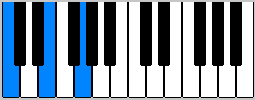
Learn to play chords with Piano For All lessons.
Learn Piano Online – F MAJOR CHORD
Let’s now take a look at the F major chord. The F major chord comprises of three notes, F, A and C.
The C Major chord is frequently followed by the F major chord and vice versa. Practice going back and forth between the C major chord and the F major chord. For the right hand, the 1st finger plays C in both chords. The 3rd finger moves up to F and the 5th finger moves up to A to form the F chord.
Here’s a picture showing the notes of the F chord on piano, starting with the note, C. 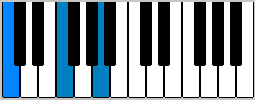
You can also hold the F chord as shown in the diagram below, starting with its root note F, then skipping a key, playing a key (A), skipping a key, playing a key (C) as we did with the C major chord. Finger 1 plays F, finger 3 plays A and finger 5 plays C.
Learn Piano – G MAJOR CHORD
The G major chord comprises of three notes, G, B and D.
Here’s a picture showing the notes of the G chord on piano: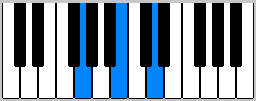
Here’s an example of the G chord on the treble clef:
Watch this lesson:
3/4 Time Signature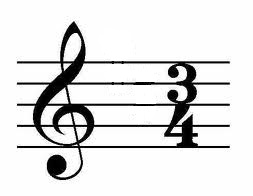
In piano lesson 5, we talked about time signatures. We saw that the top number in a time signature tells you how many beats there are in a measure (or bar) while the bottom number tells you what kind of note gets a beat.
For a 3/4 time signature there are 3 beats to a measure and a quarter note gets one beat. This means that there can be a maximum of 3 quarter notes in a measure. You can have a half note and a quarter note as well since a half note lasts two beats and a quarter note lasts one beat. You can have any combination of notes as long as they do not exceed three beats.
Dotted notes
A dotted note is a note with a small dot written after it. The dot increases the duration of the basic note by half of its original value. If the basic note lasts 2 beats, the corresponding dotted note lasts 3 beats. So while one would count two beats for a half note, if it is dotted one would have to count three beats. A quarter note gets one beat but a dotted quarter note would last a beat and a half.
Tied notes
A tie is a curved line connecting the heads of two notes of the same pitch, indicating that they are to be played as a single note with a duration equal to the sum of the individual notes’ note values.
In some cases one might tie two notes which could be written with a single note value, such as a half note tied to a quarter note (the same length as a dotted half note).
The key is held down for the combined values of both notes.
Tied and dotted notes – Example 1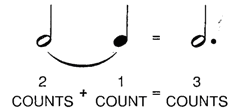
Tied and dotted notes – Example 2
Click here for my favorite How to Play Piano course. If you want to learn piano the easy way, and not have to endure technical, traditional, boring stuff, I recommend this to you.
- Free Piano Lessons – Page One.
- Online Piano Lessons – Page Two.
- Free Online Lessons (Piano) – Page Three.
- Beginner Piano Lessons – Page Four.
- Easy Piano Lessons – Page Five.
- Learn How To Play Piano Free – Page Six.
- Learn to Play the Piano – Page Seven.
- Learn to Play Piano – Page Eight.
- Keyboard Lessons – Page Nine.
- Beginner Keyboard Lessons – Page Ten.
- Learn Piano Online – Page Eleven.
- Free Piano Lessons For Beginners – Page Twelve.
- Best Way to Learn To Play Piano
Piano keyboard and free online piano lessons home page.